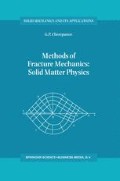Abstract
In the present chapter, we consider the connection of the classical fracture mechanics based on the crack tip study with the thermal fluctuation theory of fracture. We refine the theory, indicate some limitations and make it more useful for practical applications.
Access this chapter
Tax calculation will be finalised at checkout
Purchases are for personal use only
Preview
Unable to display preview. Download preview PDF.
References
A. P. Alexandrov and S. N. Zhurkov (1933), The Phenomena of Brittle Failure [in Russian], GONTI, Moscow.
S. N. Zhurkov (1965), Kinetic concept of the strength of solids (1965), Int. J. Fracture Mechanics, 1 (4), pp. 311–323.
V. R Regel, A. I. Slutsker, and E. E. Tomashevskii (1974), The Kinetic Nature of the Strength of Solids [in Russian], Nauka, Moscow.
G. M. Bartenev and Yu. S. Zuev (1964), The Strength and Failure of Highly Elastic Materials [in Russian], Khimiya, Moscow.
G. M. Bartenev (1974), Superstrong and Highly Strong Inorganic Glasses [in Russian], Stroiizdat, Moscow.
V. E. Gul’ (1978), The Structure and Strength of Polymers [in Russian]. Khimiya, Moscow.
G. M. Bartenev (1984), The Strength and Fracture Mechanics of Polymers [in Russian], Khimiya, Moscow.
S. N. Zhurkov (1986), The kinetic concept of the strength of solids, Vestnik AN SSSR, 3, pp. 46–52.
G. M. Bartenev (1989), The thermofluctuation theory of strength and the Griffith criterion, Problemi Prochnosti [Strength Problems], 11, p. 78.
A. A. Griffith (1920), The phenomena of fracture and flow in solids, Phil. Trans. Roy. Soc., A221, 163–198; republished in Fracture: A Topical Encyclopedia of Current Knowledge, G. Cherepanov (ed.), Krieger Publ., Melbume, USA (1996)
G. R Irwin (1958), Fracture, Handbook der Physik, 6, Springer Verlag, Berlin.
G. P. Cherepanov (1994), Nanofracture mechanics approach to dislocation generation and fracturing, Appl. Mech. Rev.,47(6), part. 2, pp. S326–330 [Invited paper at the 12th U.S. National Congress of Mechanics].
G. P. Cherepanov (1974), Mechanika Khrupkogo Razrushenia, Moscow, Nauka; English edition (1979), Mechanics of Brittle Fracture, R. de Wit and W. C. Cooley (eds.), McGraw-Hill, New York.
Computational Methods in the Mechanics of Fracture, (1986), S. Atluri (ed.), Elsevier Science Publishing, Amsterdam.
F. W. Brust, T. Nishioka, S. N. Atluri, and M. Nakagaki (1985), Further studies on elastic-plastic stable fracture utilizing the T*-integral, Eng. Fract. Mech., 22, pp. 1097–1103.
F. W Brust, J. J. Gowan, and S. N. Ahuri (1986), A combined numerical/experimental study of ductile crack growth after large unloading using T*, J, and CTOD criteria, Ing. Fract. Mech., 23, pp. 537–551.
F. W. Brust and S. N. Atluri (1986), Studies on creep crack growth using T* -integral, Eng. Fract. Mech., 23, pp. 551–575.
T. Nishioka (1996), On the dynamic J-integral in dynamic fracture mechanics, in Fracture: A Topical Encyclopedia of Current Knowledge, G. Cherepanov (ed.), Krieger Publ., Melbourne, USA.
G. P. Cherepanov (1989), Fracture mechanics and kinetic theory of strength, Probleme Prochnosti [Strength Problems, 11, pp. 3–8.
R W. Honeycomb (1968), Plastic Deformation of Metals, Edward Arnold Publ., London.
Author information
Authors and Affiliations
Rights and permissions
Copyright information
© 1997 Springer Science+Business Media Dordrecht
About this chapter
Cite this chapter
Cherepanov, G.P. (1997). Fluctuations and the Kinetic Theory of Fracture. In: Methods of Fracture Mechanics: Solid Matter Physics. Solid Mechanics and Its Applications, vol 51. Springer, Dordrecht. https://doi.org/10.1007/978-94-017-2262-9_2
Download citation
DOI: https://doi.org/10.1007/978-94-017-2262-9_2
Publisher Name: Springer, Dordrecht
Print ISBN: 978-90-481-4794-6
Online ISBN: 978-94-017-2262-9
eBook Packages: Springer Book Archive

